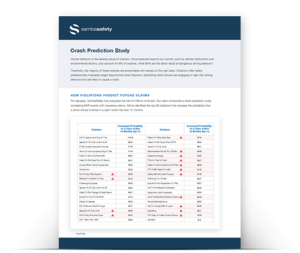Motor vehicle records (MVRs) hold a wealth of information for companies striving to understand the current and potential driver risk across their fleets. Companies that continuously monitor MVR and CSA alerts, telematics data and other critical driver activity have the greatest level of insight needed to take control of and mitigate bad driving behavior. Fleet driver violations, both major and minor, play a big role in this. By understanding the severity of each violation and the likelihood of a violation’s recurrence, safety managers can learn when and how to take action.
Violations are broken down into two main categories – major violations and minor violations. Although this classification varies state-to-state and a definitive list isn’t concretely agreed upon, we often hear the following question – “what’s the difference between major driving violations versus minor driving violations?”
We have the non-technical breakdown of major vs. minor traffic violations that even the most seasoned safety professionals may need to brush up on.
Download Our Free Crash Prediction Study to Discover the Top 38 Violations That Can Indicate a Future Crash
Different Types of Traffic Violations
What Is a Major Traffic Violation?
Major violations are serious offenses that carry heavy weight when accounted for on an MVR. Oftentimes due to the severity of the action, major violations bring about both fines and jail time. Some major violations include:
- Operating a vehicle under the influence
- Driving with a suspended or invalid license
- Reckless driving
- Behaviors including speed racing
- Using a vehicle to commit a felony
- Hit and run
- Fleeing from law enforcement
- Vehicular manslaughter or assault with a vehicle
What is a Minor Traffic Violation?
On the other hand, minor violations are really any other illegal behind-the-wheel behavior outside of the major violations listed above. When pulled over for a minor violation, your company’s drivers can expect to pay a fine, fight your violation in court or if available, utilize educational tools like traffic school to nullify the violation at hand. Examples include:
- Speeding
- Running a red light
- Failing to yield
- Failing to obey traffic devices like cones, pedestrian crossing markers or construction signs
Why Distinguishing Major vs. Minor Traffic Violations Matters
As a safety professional, distinguishing these violations proves important though in determining your company’s risk tolerance.
Intolerable Risk
A major violation is an intolerable risk. As seen by the examples listed above, these violations can be catastrophic if they occur on or even off the clock (thanks in part to negligent entrustment).
Especially in the age of the nuclear verdict, drivers in your fleet who have major violations should be cause for concern. Upon discovering this information, employers should react by engaging in targeted, intensive intervention efforts, removing those drivers from being behind the wheel as a whole or even terminating employment because it breaches their company driver safety policy.
Tolerable Risk
A minor violation is considered a tolerable risk, or risk your company is willing to take on. The risk brought upon by minor violations can prove to be corrected and isn’t always grounds for termination. They are also oftentimes indicators of crashes yet to come. Our data shows that a history of reckless, careless, inattentive or negligent driving (which is what primarily makes up minor violations) increases the likelihood of a crash by 64%.
That’s why efforts like driver training typically work best to combat minor violations. Losing your best drivers over mistakes that can be contested with education-based refreshers is an expensive habit that can greatly affect your turnover rate.
Major and Minor Violations as Part of Your Driver Risk Management Strategy
Looking at major and minor violations as a critical component of your overall driver risk management strategy is a must for any savvy safety professional, especially when considering the ramifications of violations incurred. After all, major and minor violations can cost your company more than just money. When one of your drivers engages in high-risk behaviors, they’re opening the door for a potential nuclear verdict – putting your brand and reputation at risk. That’s why it’s important to be continuously alerted on major and minor violations and understand what they may lead to, so you can take action ASAP before a future crash occurs.
Want to dive deeper into the important role major and minor violations can play in predicting and preventing crashes? Discover the most common violations that lead to crashes as well as the top violations reported by our data science team in 2022 by downloading our recent study.


